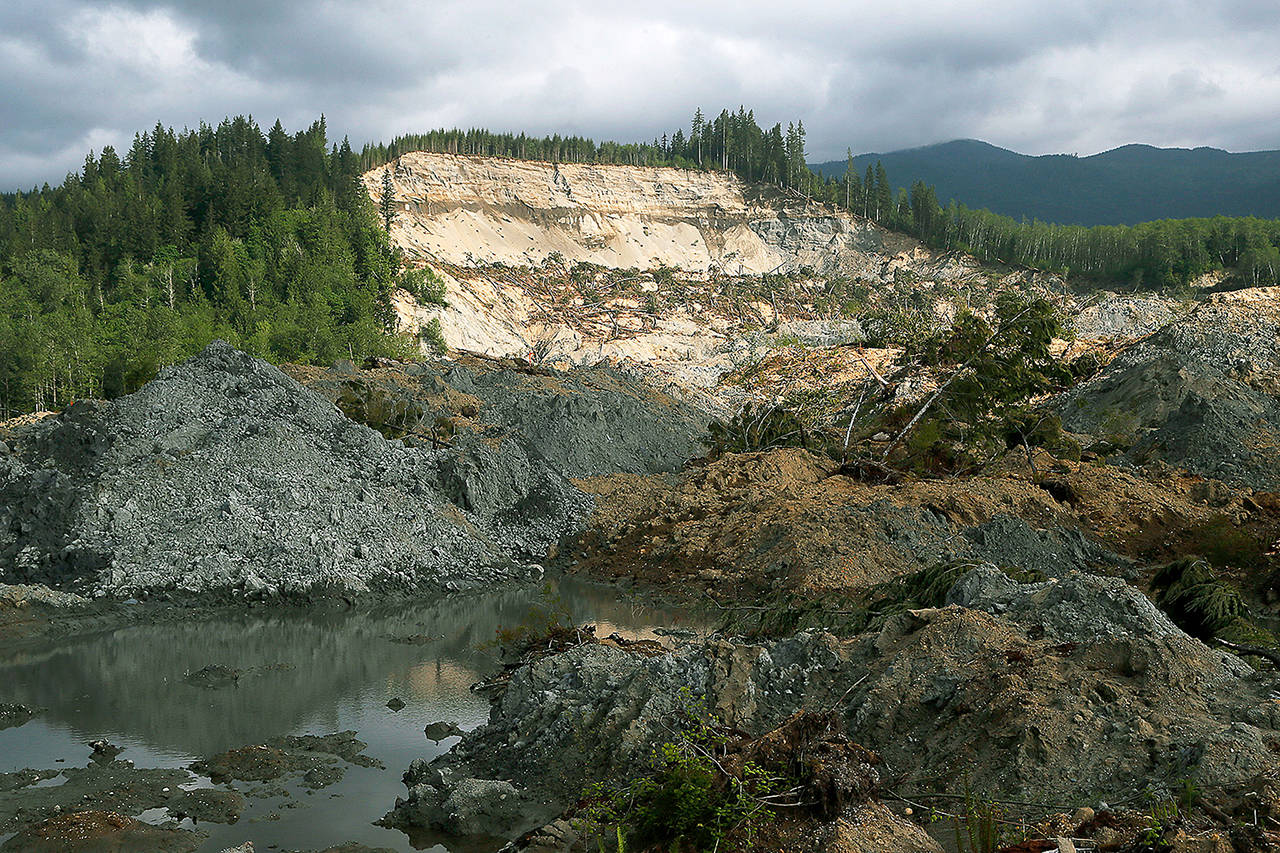SEATTLE — A judge’s ruling expected in the coming week could decide what parts of the last remaining wrongful-death lawsuit from the Oso mudslide can go to trial this fall.
Steven Hadaway’s family did not join a settlement with the state and a private timber company earlier this year. The agreement awarded several other plaintiffs $11.5 million to resolve claims related to deaths, injuries, property loss and distress suffered when the slide struck four years ago. It followed a $60 million settlement with a larger group of families in 2016.
King County Superior Court Judge Roger Rogoff listened Friday as the sides argued summary judgment motions.
“I will not rule on these motions today,” Rogoff said. “I will issue a ruling within seven days. I will do that in writing.”
A jury trial is scheduled to start in October.
No family members attended Friday’s hearing.
The slide struck on the morning of March 22, 2014. Forty-three people died, many of them in the Steelhead Haven neighborhood, on the opposite side of the North Fork Stillaguamish River from the hillside that collapsed. Dozens of others were injured or suffered property losses.
Hadaway, 53, didn’t live in the neighborhood, but he was there when the slide hit. The Darrington man was on the job as a satellite dish technician for Dish Network, doing an installation at a house. Two other local men who were putting in a water heater at the home and were also killed in the slide: William Welsh, 66, and Stephen Neal, 55 . So was the homeowner, 31-year-old nurse Amanda Lennick, who had just moved in.
It took searchers two months combing the debris field to find Hadaway’s body. The Marine Corps veteran was the second-to-last slide victim found.
The lawsuit was filed in March 2017 by Hadaway’s widow, Margaret Hadaway, on behalf of his estate and his two daughters.
It seeks unspecified damages from the state of Washington, Snohomish County and Grandy Lake Forest Associates LLC, a Mount Vernon-based timber company.
The suit claims that a documented history of landslides on the hill going back to at least the 1940s should have prompted government officials to take greater steps to protect people in the area. It faults the state Department of Natural Resources for its decision in 2004 to approve a 7.5-acre clear-cut by Grandy Lake above the slope. The suit alleges that logging allowed more rainwater to seep into the ground, making the hillside less stable.
A DNR investigation concluded that permitting for the clear-cut was done properly, but that the company exceeded the approved size by an acre.
In 2006, a massive slide on the slope below had blocked the North Fork Stillaguamish River but did not cross into the Steelhead Haven neighborhood. The lawsuit claims the defendants failed to adequately monitor or warn neighbors about increased dangers after that incident. Recent scientific studies generally agree that the 2006 slide helped trigger the catastrophe eight years later.
The complaint alleges the county and state should have known that a wooden crib wall installed at the toe of the slope later in 2006 would have done little to prevent the collapse of the 600-foot-tall hillside.
“These measures were designed to keep debris out of the river to protect fish habitat, and to prevent flooding, but they were not designed to protect human lives from future landslides,” the complaint says.
The county was dismissed in 2016 from the earlier round of Oso wrongful death suits. An appeal is pending and could bring the county back into the case, if the trial court is overturned.
Pre-trial questions for the judge include whether the jury should be allowed to consider how the crib wall and a sediment pond might have affected the distance the slide debris traveled.
“The landslide would have reached the Lennick property without the crib wall,” said Raymond Weber, a private-practice attorney representing the state.
Other considerations include whether the state or Grandy Lake had a duty to warn people who lived in the area of potential dangers.
“You could have a community warning similar to what you have with wildfires,” said Darrell Cochran, a Tacoma-based attorney representing Hadaway’s estate. “The experts have said you had a duty to monitor and a duty to warn and that could have taken a number of forms.”
The house where Hadaway was working was close to the river and one of the first hit by the slide.
“There were no survivors anywhere near the Lennick property,” said Caryn Geraghty Jorgensen, another private attorney representing the state.
The proximity might make it more difficult to compare eyewitness accounts with Hadaway’s point of view, as survivors had more time to react. The timing is important to the case because it speaks to how much fear Hadaway might have experienced, had he realized what was about to happen as the mudslide approached.
Noah Haglund: 425-339-3465; nhaglund@heraldnet.com. Twitter: @NWhaglund.
Talk to us
> Give us your news tips.
> Send us a letter to the editor.
> More Herald contact information.

























